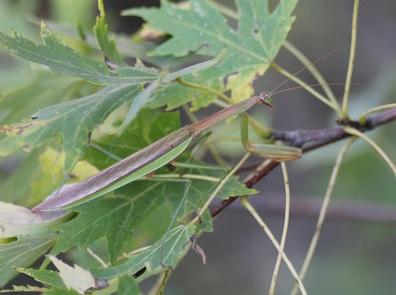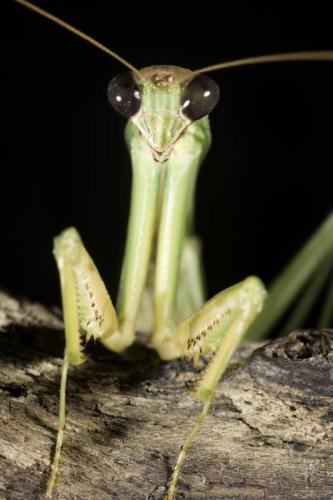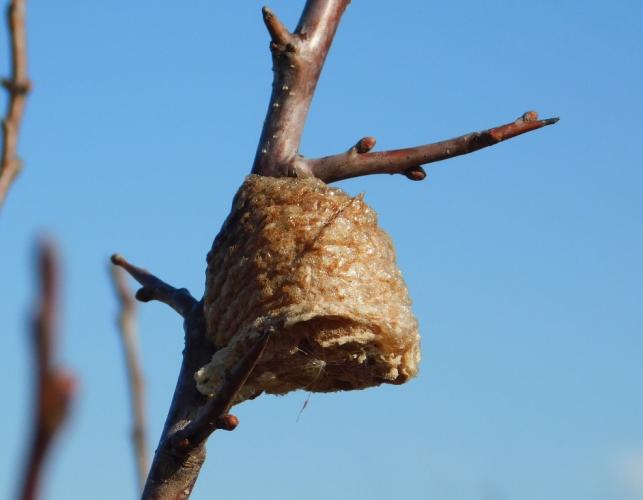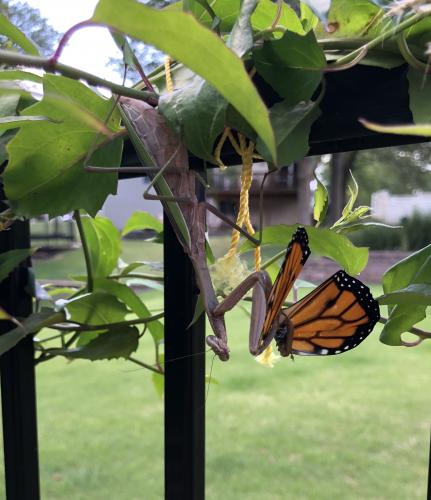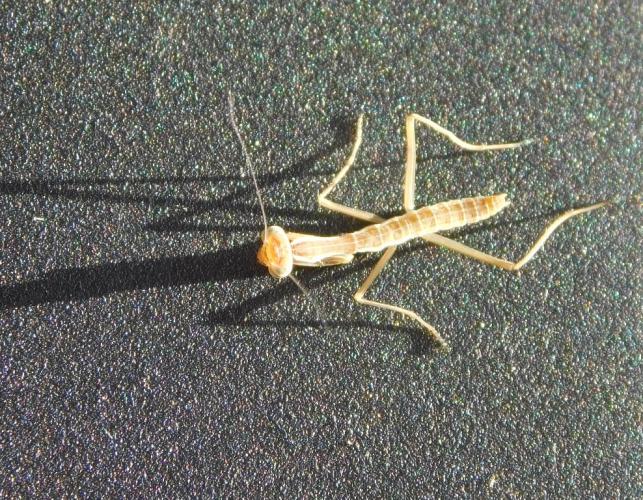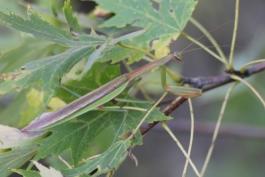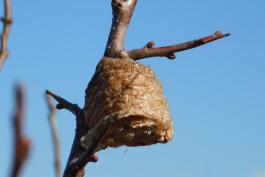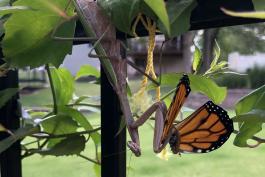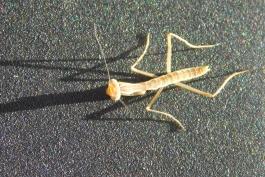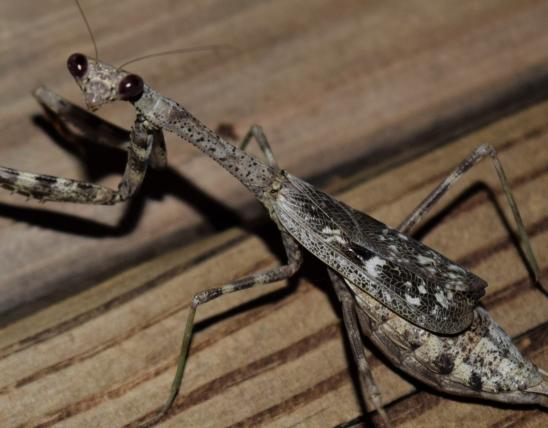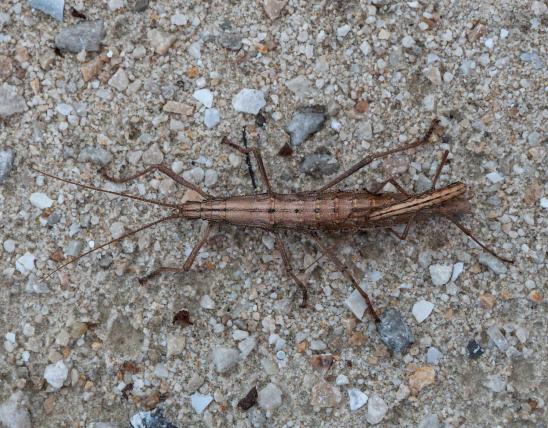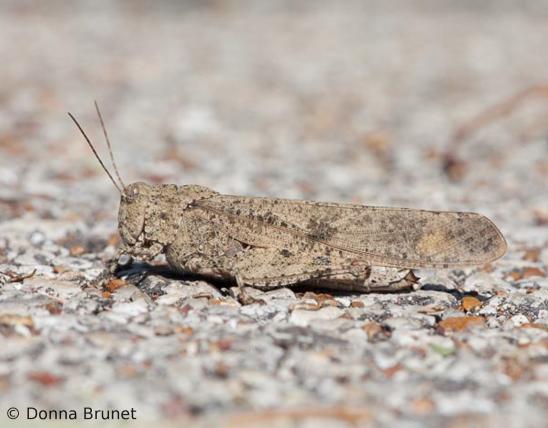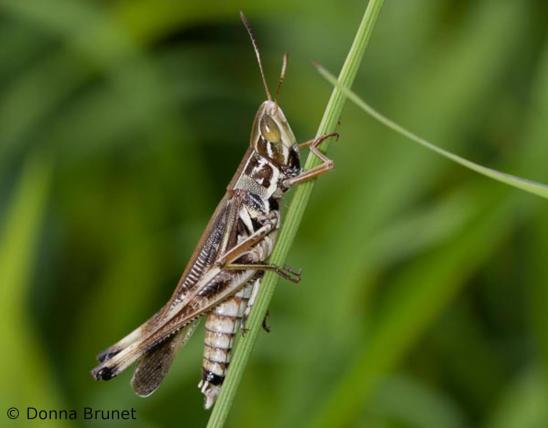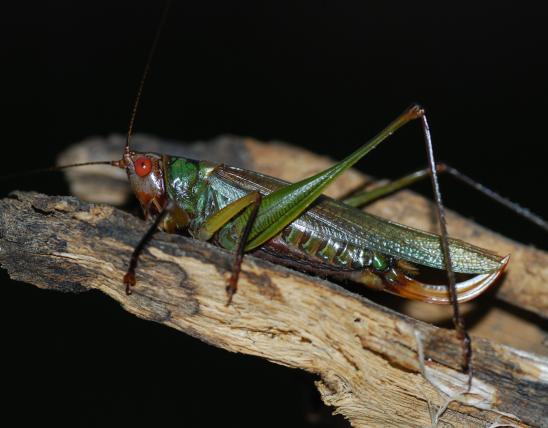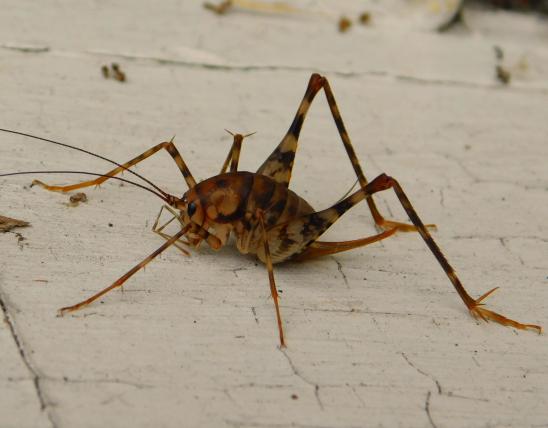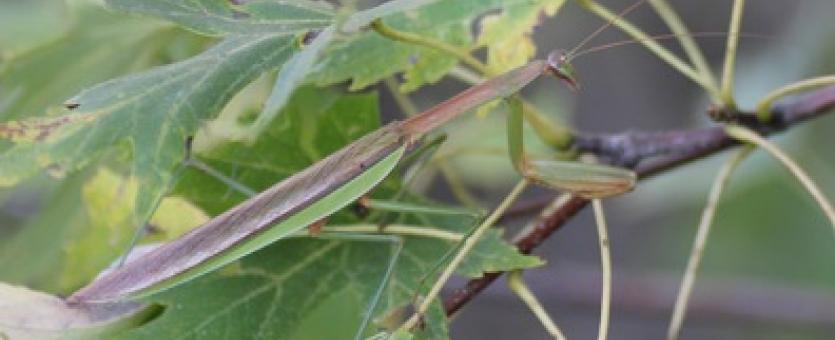
Chinese mantises can reach 5 inches long and range from pale green to tan — usually tan, with a green line running down the side (the edges of the forewings). The head is triangular and swivels, so the mantis can track prey without otherwise moving. Examine the facial shield (the part of the face in front of the antennae and between the eyes): in the Chinese mantis, it is fairly square and has vertical stripes.
Immature mantids look a lot like the adults, but without fully developed wings. Very young mantids often have the abdomen tip curled upward.
Egg cases resemble tan toasted marshmallows. They are fairly round, about as long as wide, Ping-Pong-ball size; usually attached to twigs of bushes and small trees.
Similar species:
- The European mantis (Mantis religiosa) is another nonnative mantis introduced to America, but it grows only to about 3 inches, and its color ranges from tan to bright green. A key diagnostic feature is a round black dot on the underside of the basal joint (coxa) of the big forelegs. Sometimes this black dot has a white center. This spot can be hard to see when their “arms” are held together.
- The Carolina mantis (Stagmomantis carolina) is native to the United States; it is smaller, only reaching about 2½ inches. It is pale green to tan or mottled gray, and the wings extend only three-fourths of the way down the abdomen in adult females.
Length: to 5 inches. Females are larger than males.

Statewide.
Habitat and Conservation
Mantises perch in tall plants or other areas with a view, waiting to snatch any insect that flies or crawls past. People usually see them in or near the vegetation around houses as well as in grasslands, pastures, agricultural areas, and other open areas. Although mantises are fierce predators to insects, this species is considered harmless to humans. Indeed, some people keep them as pets.
Chinese mantises were introduced to North America in 1896 and have spread since then. Because they have been widespread for so long, it is difficult to determine what their ecological impact has been on native ecosystems.
Nonnative mantids may be outcompeting our native North American mantids, contributing to their decline. To help reduce their negative impact on native populations, you can selectively destroy individual Chinese and European mantids and their egg cases, and let our native Carolina mantis species alone. Meanwhile, other people purchase nonnative Chinese mantid egg cases and release them in a rather inefficient attempt to battle garden or crop pests.
Because of the females’ large size, they have occasionally been recorded eating small vertebrates, including small reptiles and amphibians and even hummingbirds, but these seem to be relatively rare occurrences that do not have a significant impact on populations of those species. The hunting activities of nonnative domestic cats and dogs, loss of habitat, fragmented or degraded habitat, and/or climate change probably have larger impacts on the populations of these reptile, amphibian, and bird species.
Food
Chinese mantises are lie-in-wait predators, sitting motionless and waiting for their prey to fly or walk by. The mantis’s folded arms fly out quickly to grasp the prey and then hold it fast while feeding ensues. Mantises eat all kinds of insects and spiders, and adult females of this species have been known to eat small reptiles, amphibians, and even hummingbirds.
Status
Common statewide. Nonnative. First introduced in 1896. Long established in North America.
Life Cycle
Most mantids live for only about a year. They hatch in spring and spend the rest of the growing season eating, growing, and molting. They mate and lay eggs in late summer and die when it freezes. Eggs overwinter in egg cases (ootheca).
At the end of the growing season, females have large abdomens full of eggs. They deposit their eggs onto twigs, bark, or other structure in masses called ootheca. The eggs are extruded within a glob of frothy material called spumaline, which, when it hardens, feels something like crusty, dry Styrofoam. The tough ootheca egg case protects the eggs all winter. In spring, the young hatch out almost all at once. If they cannot disperse right away, they will eat each other.
The mating of mantids is famous, because the female sometimes eats the male during copulation, starting with his head. The male’s body is able to complete sperm transfer, even though his head is missing. The female usually ends up eating the rest of the male. This seems ghoulish, but remember that mantids would eat one another almost anytime, if confined in close quarters. Also, most of the times this cannibalism has been recorded, it occurred in captivity; it appears to be less frequent in nature.
In a very real way, the male’s sacrifice helps ensure that his offspring will survive. His body helps nourish his mate, contributing to her health and her production of high-quality eggs and egg cases. And the female’s hunting instinct and ravenous appetite serves her by helping to ensure she hunts steadily at a time when she needs plenty of food.
Human Connections
It is tempting to simply label all insect-eating insects as “beneficial,” but black-and-white judgments on the human value of mantids are problematic. Mantids eat many pest insects, but they also eat insects that humans tend to appreciate, such as other insect predators, pollinators, butterflies, and so on.
Egg cases of nonnative mantids, including the Chinese mantis, are still bought and sold in many places in the hope of controlling agricultural and garden pests. Because of their indiscriminate diet (eating beneficial as well as pest insects) their usefulness is questionable. If you want to control pests biologically, by encouraging a variety of insect predators, avoid using broad-spectrum insecticides.
Because of the Chinese mantid’s possible role in the decline of some native North American mantids, the use of that species seems ill-advised. If you want to experiment with mantids as pest control agents, try using the egg cases of our native Carolina mantis. Many people kill Chinese mantids and destroy Chinese mantid egg cases, in hopes that their removal will improve ecological balance.
Mantids are often described not just as “predators” but as “deadly predators.” A moment’s reflection reveals the emotional and redundant charge in the latter phrase. We humans feel satisfied when mantids consume invasive stinkbugs, annoying houseflies, or moths whose caterpillars chomp our tomato plants, but it disturbs us when they capture honeybees, pretty butterflies, or other seemingly innocent insects.
Nonnative or invasive? Beneficial or pest? The distinction between nonnative and invasive usually hinges on whether or not the nonnative organism takes over or disrupts healthy ecosystems, or clearly causes serious declines of native organisms. The distinction between beneficial and pest usually hinges on the organism’s role in human economic (usually agricultural) interests — weighing its total impact, including both pros and cons. The case of the Chinese mantis seems complicated, apparently, by some combination of the following possible factors:
- The amount of unequivocal data on the Chinese mantis’s impact on native ecosystems and/or populations of native organisms
- The longstanding, already widespread North American distribution of the Chinese mantis, which complicates a researcher's ability to gauge its environmental impact and hampers any attempts to contain or control its numbers
- The costs, and likelihood of success, of trying to control its numbers
- The continuing desire of people to be free to buy, sell, and use them as biocontrol agents
- The issue’s position relative to a lengthy list of conservation and agricultural priorities.
Ecosystem Connections
Usually when we consider insects that play a role in the food chain, we think of herbivorous insects, which eat plants and pass the nutrients along to insect-hunting birds, amphibians, reptiles, bats, and other vertebrates. But mantids and other insect-hunting insects are generally larger than the insects they hunt and provide a bigger meal for an insect-eating vertebrate. Many birds, especially, hunt insects during breeding season because of their high protein content.
As with many other species, the young are particularly vulnerable to predation. Mortality is high among immature mantids, as their bodies become food for a wide variety of predators. Jumping spiders, for example, patrol the same plant stems that young mantids walk around on, and they won’t hesitate to pounce on young mantids small enough to subdue.
Mantids aren’t the only species where the male is sometimes eaten by the female. In many spiders, the female may eat her much smaller mate. And in a more general way, in many animals, males that share in the rearing of offspring — establishing and defending a territory that supplies sufficient food, constructing nests, protecting or incubating eggs, gathering food, feeding the young, caring for the mother — are spending a significant amount of their lives in order to ensure their reproductive success.
